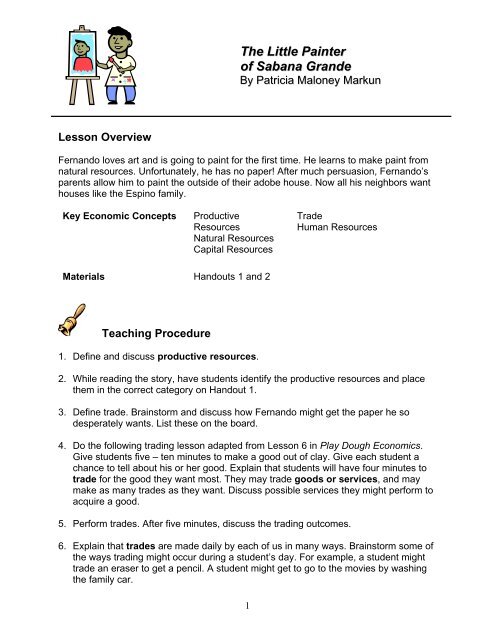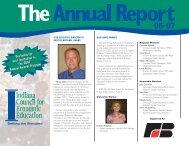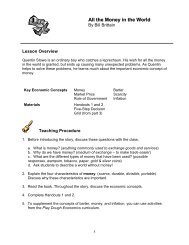The Little Painter of Sabana Grande
The Little Painter of Sabana Grande by Patricia Maloney Markun
The Little Painter of Sabana Grande by Patricia Maloney Markun
You also want an ePaper? Increase the reach of your titles
YUMPU automatically turns print PDFs into web optimized ePapers that Google loves.
<strong>The</strong> <strong>Little</strong> <strong>Painter</strong><strong>of</strong> <strong>Sabana</strong> <strong>Grande</strong>By Patricia Maloney MarkunLesson OverviewFernando loves art and is going to paint for the first time. He learns to make paint fromnatural resources. Unfortunately, he has no paper! After much persuasion, Fernando’sparents allow him to paint the outside <strong>of</strong> their adobe house. Now all his neighbors wanthouses like the Espino family.Key Economic ConceptsProductiveResourcesNatural ResourcesCapital ResourcesTradeHuman ResourcesMaterials Handouts 1 and 2Teaching Procedure1. Define and discuss productive resources.2. While reading the story, have students identify the productive resources and placethem in the correct category on Handout 1.3. Define trade. Brainstorm and discuss how Fernando might get the paper he sodesperately wants. List these on the board.4. Do the following trading lesson adapted from Lesson 6 in Play Dough Economics.Give students five – ten minutes to make a good out <strong>of</strong> clay. Give each student achance to tell about his or her good. Explain that students will have four minutes totrade for the good they want most. <strong>The</strong>y may trade goods or services, and maymake as many trades as they want. Discuss possible services they might perform toacquire a good.5. Perform trades. After five minutes, discuss the trading outcomes.6. Explain that trades are made daily by each <strong>of</strong> us in many ways. Brainstorm some <strong>of</strong>the ways trading might occur during a student’s day. For example, a student mighttrade an eraser to get a pencil. A student might get to go to the movies by washingthe family car.1
7. Encourage students to make trades throughout one week, using Handout 2 tomonitor the trades. At the end <strong>of</strong> the week, discuss the trading outcomes.Key Questions To Ask Students1. What productive resources did Fernando use to create his paintings? (charcoal,berries, dried grass, clay, paintbrushes, clay pots, adobe house, himself)2. Which are natural, capital, and human resources? (natural: charcoal, berries,dried grass, clay, capital: clay pots, paintbrushes, adobe house; human: Fernando)3. How could Fernando have gotten the paper he wanted? (buy it, trade a good for it,trade a service for it)4. When people make a trade, who benefits? Why? (both, since they both get whatthey want)5. Why is trading sometimes difficult? (Each person must want what the other has. Weuse money to make trade easier.)Follow-up Activities1. Nature’s Own Colors: Create your own set <strong>of</strong> colors using natural resources. Teabags in warm water create brown. Onion skins boiled in water create golden yellow.Mashed beets or crushed red raspberries give a reddish purple color; crushedblueberries provide blue. Research and create other colors. Paint with all thesenatural colors. Let students trade for a color they do not have.2
Handout 1<strong>The</strong> <strong>Little</strong> <strong>Painter</strong>’s Productive ResourcesName ___________________________As you read, list the productive resources mentioned in the story. Decideif they are natural, human, or capital resources.Human______________________Natural____________________Capital_____ _____Pretend that you are a candle maker. Draw or cut out picturesfor the productive resources that you might use.Human Natural Capital__________3
Handout 2<strong>The</strong> Trades I Make!Name ________________________For one week, keep track <strong>of</strong> the trades in Section A that you make toacquire the goods or services you want. At the end <strong>of</strong> the week, completeSection B at the bottom <strong>of</strong> the page.SECTION ADay <strong>of</strong> Week What I Traded What I ReceivedSECTION B(Use tally marks to complete this section.)1. Number <strong>of</strong> trades: __________2. Number <strong>of</strong> goods traded for goods: __________3. Number <strong>of</strong> goods traded for services: __________4. Number <strong>of</strong> services traded for goods: __________5. Number <strong>of</strong> services traded for services: __________4




